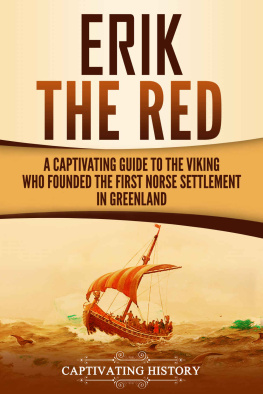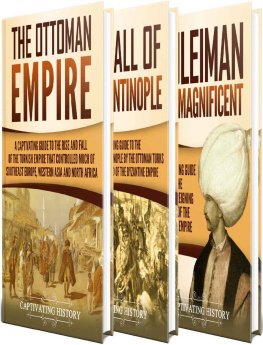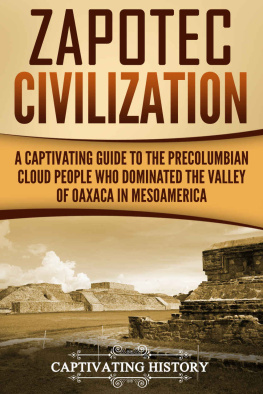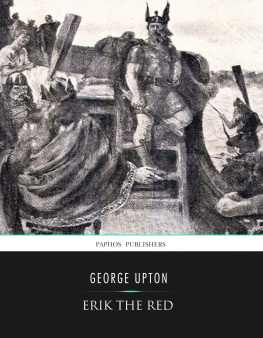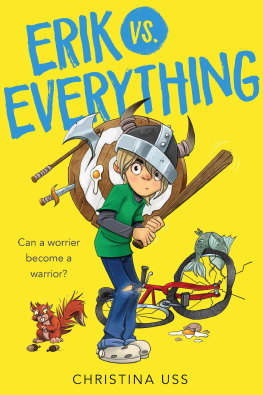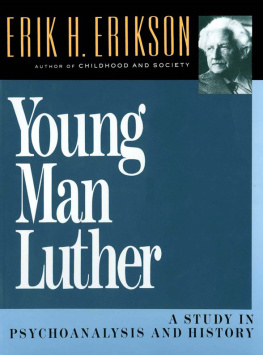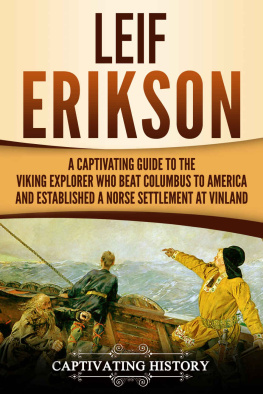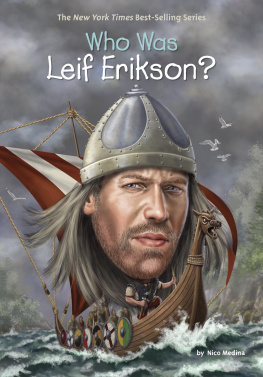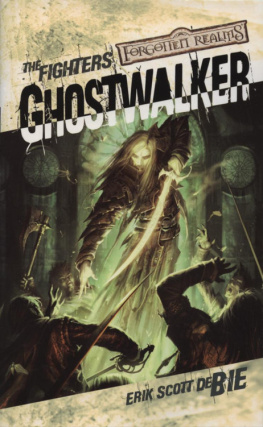Erik the Red
A Captivating Guide to the Viking Who Founded the First Norse Settlement in Greenland
Copyright 2018
All Rights Reserved. No part of this book may be reproduced in any form without permission in writing from the author. Reviewers may quote brief passages in reviews.
Disclaimer: No part of this publication may be reproduced or transmitted in any form or by any means, mechanical or electronic, including photocopying or recording, or by any information storage and retrieval system, or transmitted by email without permission in writing from the publisher.
While all attempts have been made to verify the information provided in this publication, neither the author nor the publisher assumes any responsibility for errors, omissions or contrary interpretations of the subject matter herein.
This book is for entertainment purposes only. The views expressed are those of the author alone, and should not be taken as expert instruction or commands. The reader is responsible for his or her own actions.
Adherence to all applicable laws and regulations, including international, federal, state and local laws governing professional licensing, business practices, advertising and all other aspects of doing business in the US, Canada, UK or any other jurisdiction is the sole responsibility of the purchaser or reader.
Neither the author nor the publisher assumes any responsibility or liability whatsoever on the behalf of the purchaser or reader of these materials. Any perceived slight of any individual or organization is purely unintentional.
Table of Contents
Free Bonus from Captivating History: History Ebook
Hi History Lovers!
My name is Matt Clayton, and Im the creator of Captivating History. First off, I want to THANK YOU for reading our books in the Captivating History series. As an avid reader of History myself, I aim to produce books that will hold you captive.
Now you have a chance to join our exclusive history list so you can get the ebook below for free as well as discounts and a potential to get more history books for free! Simply click the link below to join.
P.S. If you join now, you will also receive a free Mythology book. Remember that its 100% free to join the list.

Click here to access your bonus
Also, make sure to follow us on:
Twitter: @Captivhistory
Facebook: Captivating History: @captivatinghistory
Introduction
A formidable figure with flaming red hair, a wild beard, and a temper to match is not the type of person most people would choose to cross swords with. And that, by all accounts, is a fitting description of Erik the Red. This was not a man to be taken lightly or challenged in battle. He was courageous on the battlefield, an accomplished seafarer, indomitable warrior, and unstoppable adventurer. In short, Erik the Red was everything we imagine a Viking to be.
He perfectly fits the familiar image of the fearsome Scandinavian warriors who spent their days attacking, raiding, and plundering vulnerable coastal and riverside settlements, and their nights feasting, drinking, and telling tales of their daring exploits. And no doubt Erik did his fair share of raiding, looting, and killing. He was a large, strong Norseman, who could wield a double-edged sword or axe with skill and did not shy away from confrontation. Erik the Red was no doubt a violent man who was not averse to killing, in battle or in the heat of an argument. He would have joined his fellow Norsemen as they ruthlessly preyed on weaker communities, small settlements, churches, and monasteries. He most likely stood at the helm of a light, shallow-hulled dragon boat as it traveled upriver to swiftly attack an unsuspecting community and then sail away with a boatload of loot before any effective defense or counter-attack could be launched. But that is only part of the picture. There was so much more to Erik the Red and his fellow Vikings than the popular image of ruthless men who showed their victims no mercy.
Vikings were, for the most part, farmers and traders who for various reasons, mostly commercial, took to raiding towns, churches, and monasteries, as a part-time activity. They usually returned to their farms in time for the harvest, and Erik the Red was no different. He was a typical Norse farmer who took part in raiding expeditions when he wasnt needed on the farm and later became a famous Viking explorer who established the first European settlement on the island of Greenland.
Chapter 1 Erik the Reds Early Life in Norway
Erik Thorvaldsson, better known by his nickname Erik the Red, was the son of a Norwegian farmer, Thorvald Asvaldsson. Not much is known about Thorvald Asvaldsson or Eriks early life in Norway. It was probably the typical life of a Norwegian farmer, working the land and caring for the livestock. There is no information about Eriks siblings or other family members; not even his mothers name is recorded in the Nordic sagas.
What is known is that Erik was born sometime around 950 CE in Rogaland on the southwestern coast of Norway, and at the age of about ten, he traveled with his family to Iceland. This was not a voluntary relocation. Thorvald moved with his family to Iceland out of necessity rather than desire. He may have been the father of one of the greatest Norse explorers, but he does not appear to have been an adventurous man himself. He wasnt seeking to carve out a niche for himself in the colonies, nor was he a man with strong political ambitions who was seeking fame and fortune; Thorvald was a man on the run. He was forced to flee Rogaland after he was banished or outlawed from Norway for killing another Viking.
At the time when Erik the Red was born, the Vikings had a reputation for ruthlessness and lawlessness, but Norse society was actually highly regulated, and they had well-established laws and governance. Vikings may not have been averse to violence and killing, but they lived within a structured society in their own settlements and criminal behavior did not go unpunished.
When Thorvald Asvaldsson murdered a fellow Norseman, he was tried at the Thing and found guilty by his fellow Norsemen. As a result, he was banished from Norway. Under Norse law this was the ultimate punishment for Thorvald Asvaldsson and, by extension, his family. He had to forfeit all his property and was forced to flee, not only from his village, but from Norway itself. Fortunately for Thorvald Asvaldsson, he lived during the Viking Age, a time of Scandinavian exploration and expansion which meant that he had options. The most obvious answer to his predicament was to take his family and flee to the newly established settlement on Iceland.
Viking law was well established and was the root of their government. The Vikings did not have a central government, but the rule of law, fairness, and justice was important to them. They lived in an ordered and structured society made up of small settlements, and each settlement had a chief. Decisions regarding village life were made at the Thing. The Thing can be compared to a legislative assembly. The chief of the settlement ran the Thing, but he and his council could only guide the Thing, and all free men had the right to take part in the decision-making process. At a Thing, the members of a settlement voted on day to day issues, including who owned a piece of land or what punishment a person would receive if they were found guilty of breaking the law.
A Thing was a public gathering that could be held at any time, and gave all free men in a settlement the opportunity to settle disputes and express their views on certain matters. Once a year the clan gathered for the Althing. This was an annual event where new laws were made and the Vikings could vote on important decisions like taxes, peace treaties, and the election of a new chief.

